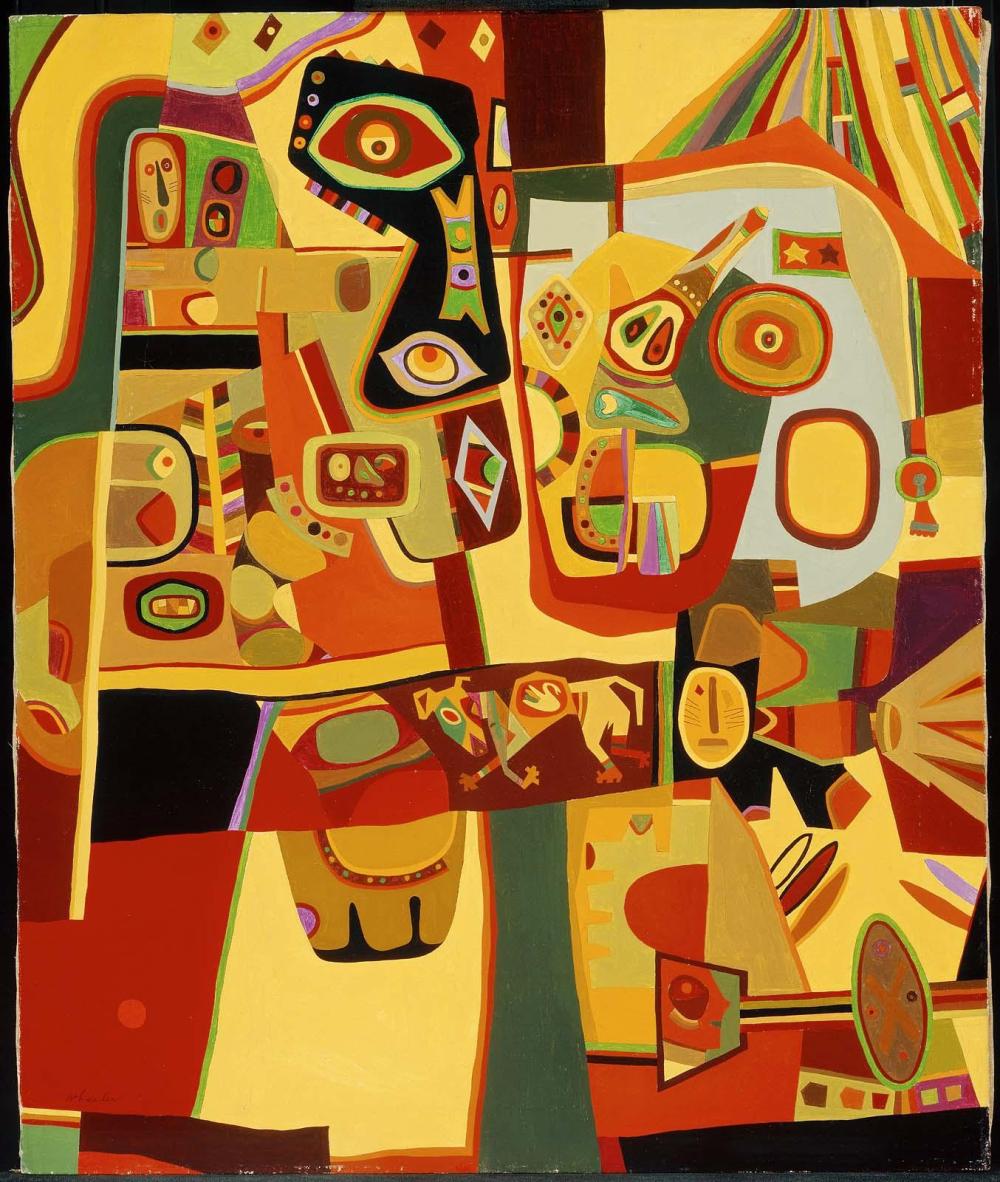Advanced Search 

Man Menacing Woman
Steve Wheeler (1912–1992)
American
about 1943
Medium/Technique
Oil on canvas
Dimensions
76.2 x 63.5 cm (30 x 25 in.)
Credit Line
Sophie M. Friedman Fund
Accession Number2002.127
NOT ON VIEW
CollectionsAmericas
ClassificationsPaintings
Steve Wheeler created Man Menacing Woman during his association with a loose confederation of artists known as the Indian Space Painters, active from the early 1940s through the 1950s. While studying at the Art Students League in New York and with abstract artist Hans Hofmann [http://www.mfa.org/search/collections?artist=Hofmann&objecttype=54] in the early and mid-1930s, Wheeler had met fellow students Robert Barrell and Peter Busa [2005.121], and with them he became increasingly interested in Native American and Pre-Columbian art. Together, they studied the collections on display in New York City at the American Museum of Natural History, the Brooklyn Museum, and the Heye Foundation’s Museum of the American Indian (now the National Museum of the American Indian’s George Gustav Heye Center). By the early 1940s, Wheeler and his circle of colleagues, which had expanded to include artists Will Barnet [http://www.mfa.org/search/collections?artist=Will%20Barnet&objecttype=54], Gertrude Barrer, and Howard Daum, sought to invent a modernist style rooted in Native forms, hoping to develop an abstract visual language based entirely on American, rather than European, sources.
In Man Menacing Woman, Wheeler appropriated Native American motifs, particularly those found in the Northwest Coast art of the Kwakiutl [1998.3], Tlingit [2008.650], Haida [99.593], and other Native American peoples in Oregon, Washington State, and British Columbia. Perhaps most familiar from textiles and totem poles, Northwest Coast art is distinguished by the stylization, splitting, and patterning of forms to cover an entire surface; carvings often depict mythical animals or figures in a hard-edged, linear manner. With its pictographic forms of varying sizes, vivid color, and densely patterned composition, Man Menacing Woman adapts these visual conventions to twentieth-century abstract painting. The small doglike form in the center of Wheeler’s painting recurs in several of his works, and is part of a mysterious personal pantheon of mythic forms he invented. While his style may be drawn from culturally distant sources, Wheeler’s subjects, many of which were described in his 1947 illustrated autobiography Hello Steve, are often personal. [1] Those who knew him described Wheeler as somewhat aggressive, intense, and stubborn. [2] The title of this painting, Man Menacing Woman, may reflect Wheeler’s acknowledgment of that aspect of his personality.
Though Wheeler later repudiated his involvement with the Indian Space Painters, the short-lived group pioneered the development of allover painting (or painting concerned with two-dimensional patterning), which became one of the hallmarks of the Abstract Expressionist movement in the late 1940s. In this manner, Wheeler and his fellow artists helped to shape the course of American modernism.
Notes
1. Steve Wheeler, Hello, Steve, including a work of prose by John Storck, with an essay on the work of the artist by Adam Gates (New York: Press Eight, 1947).
2. Oral history interview with Will Barnet, April 9, 1993, Archives of American Art, Smithsonian Institution, Washington, D.C.
Heather Hole
In Man Menacing Woman, Wheeler appropriated Native American motifs, particularly those found in the Northwest Coast art of the Kwakiutl [1998.3], Tlingit [2008.650], Haida [99.593], and other Native American peoples in Oregon, Washington State, and British Columbia. Perhaps most familiar from textiles and totem poles, Northwest Coast art is distinguished by the stylization, splitting, and patterning of forms to cover an entire surface; carvings often depict mythical animals or figures in a hard-edged, linear manner. With its pictographic forms of varying sizes, vivid color, and densely patterned composition, Man Menacing Woman adapts these visual conventions to twentieth-century abstract painting. The small doglike form in the center of Wheeler’s painting recurs in several of his works, and is part of a mysterious personal pantheon of mythic forms he invented. While his style may be drawn from culturally distant sources, Wheeler’s subjects, many of which were described in his 1947 illustrated autobiography Hello Steve, are often personal. [1] Those who knew him described Wheeler as somewhat aggressive, intense, and stubborn. [2] The title of this painting, Man Menacing Woman, may reflect Wheeler’s acknowledgment of that aspect of his personality.
Though Wheeler later repudiated his involvement with the Indian Space Painters, the short-lived group pioneered the development of allover painting (or painting concerned with two-dimensional patterning), which became one of the hallmarks of the Abstract Expressionist movement in the late 1940s. In this manner, Wheeler and his fellow artists helped to shape the course of American modernism.
Notes
1. Steve Wheeler, Hello, Steve, including a work of prose by John Storck, with an essay on the work of the artist by Adam Gates (New York: Press Eight, 1947).
2. Oral history interview with Will Barnet, April 9, 1993, Archives of American Art, Smithsonian Institution, Washington, D.C.
Heather Hole
DescriptionAfter reading artist Robert Henri's The Art Spirit (1923), Wheeler was determined to attend the Art Students League in New York City, where Henri had taught. There Wheeler met fellow students Robert Barell and Peter Busa, and together they became increasingly interested in native American and Precolumbian art then displayed in various collections in the city. Although intimately familiar with the Abstract Expressionist circle, Wheeler became disillusioned with the art world and his work was largely forgotten until the last decade. This composition exhibits his mature style known as Indian Space painting for its richly layered application of pigment and surreal forms inspired by native American and Precolumbian signs and symbols.
Signed
lower left: Wheeler
ProvenanceAbout 1943, the artist; 1992, the artist's estate. By 2002, Richard York Gallery, N.Y.; 2002, sold by the Richard York Gallery to the MFA. (Accession Date: June 26, 2002)
